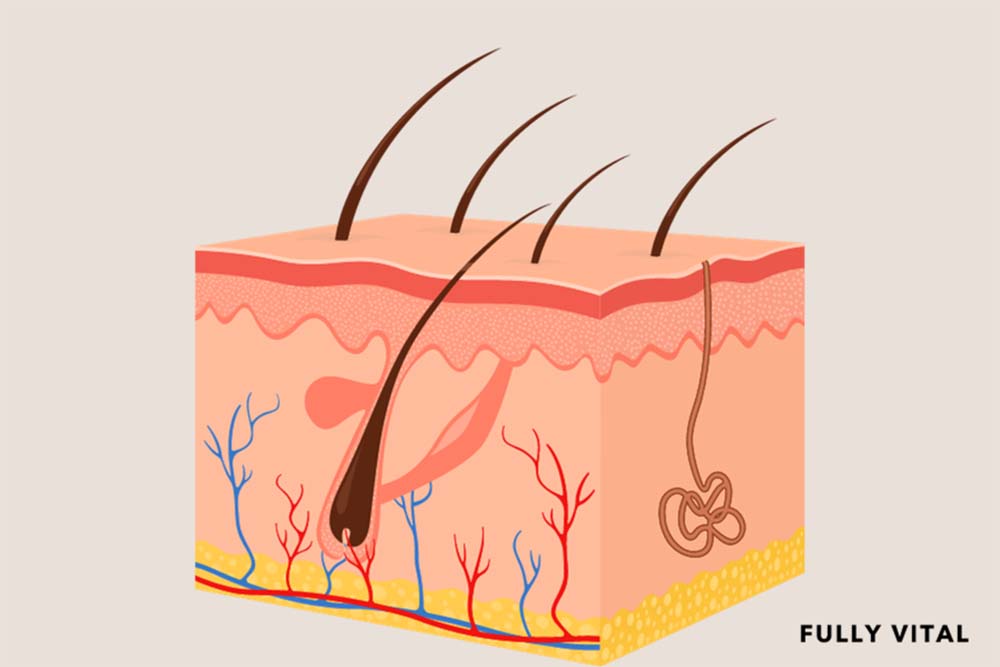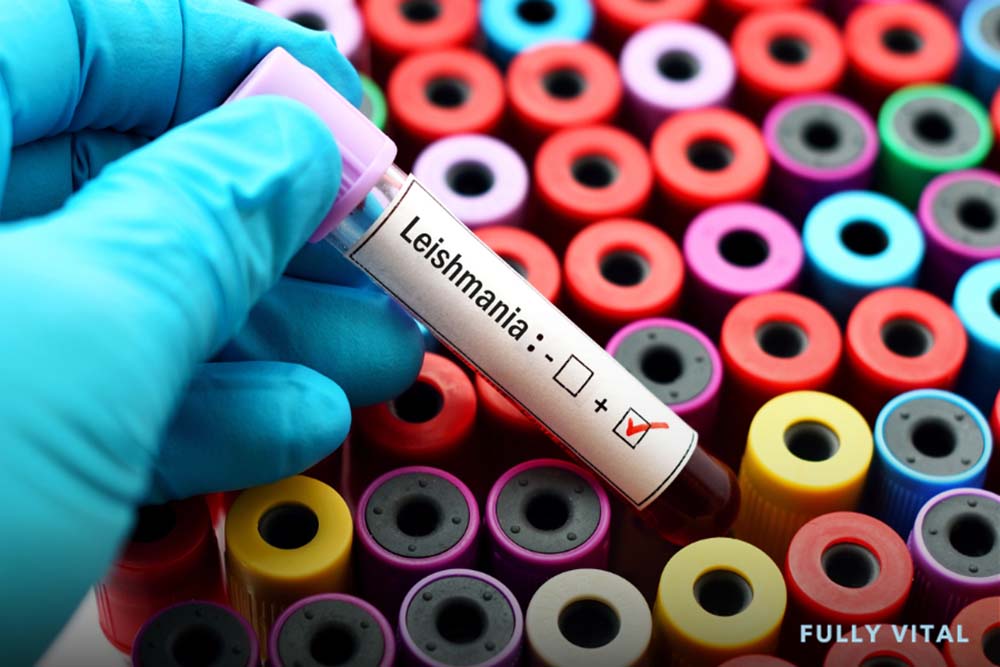
Understanding Sebaceous Glands: A Key To Unlocking Hair Growth Potential
In our relentless pursuit of luscious locks, we often encounter terms like "sebaceous gland" that may leave us scratching our heads.
Fear not, for in this article, we'll demystify the sebaceous gland, its significance in the realm of hair growth, and everything you need to know.
So, whether you have curly, straight, or wavy hair, join us on this journey to discover the secrets of your scalp.

I LOVE MY HAIR NOW
FullyVital hair serum and hair vitamins made tremendous improvements in my hair. I truly love my hair now.
Dorit S.,
What Is A Sebaceous Gland?
Let's start at the root of the matter—what exactly is a sebaceous gland? These tiny, yet mighty glands are nestled within your skin, including your scalp.
Their primary role is to produce sebum, an oily substance that helps keep your skin and hair moisturized.

Why Is The Sebaceous Gland Important For Hair Growth?
The sebaceous gland plays a pivotal role in the quest for hair growth. Here's why it's a true hair hero:
Natural Moisturization
Sebum, the oil secreted by sebaceous glands, acts as a natural conditioner for your hair, preventing dryness and breakage.(1)
Scalp Health
A healthy scalp is essential for robust hair growth, and sebaceous glands contribute by keeping the scalp nourished and hydrated.
Protection
Sebum forms a protective barrier on the skin's surface, shielding it from environmental stressors that can hinder hair growth.
How Does The Sebaceous Gland Work?
The sebaceous gland's operation is fascinating. It's like a tiny factory within your skin:
- Production: These glands continuously produce sebum, which travels up hair follicles to reach the skin's surface.
- Self-Regulation: The amount of sebum produced is regulated by your body, ensuring just the right amount for optimal hair health.
- Distribution: Sebum spreads across your scalp, forming a protective layer and providing moisture.
What Are The Benefits Of Sebaceous Glands?
Sebaceous glands bring a multitude of benefits to the table (or, in this case, your scalp):
- Healthy Hair Growth: Sebum nourishes hair follicles, promoting healthy and vibrant hair growth.
- Natural Shine: Sebum imparts a natural shine to your hair, making it look lustrous and healthy.
- Protection: The sebum barrier protects your hair and scalp from external aggressors.
Are There Any Downsides To Sebaceous Glands?
While sebaceous glands are generally beneficial, there can be downsides, such as:
- Excess Sebum: Overactive sebaceous glands can lead to oily hair and scalp, which may require more frequent washing.
- Clogged Pores: Excessive sebum production can sometimes clog hair follicles, potentially leading to issues like dandruff or acne.2
What Are The Sebaceous Glands In Hair Structure?
Before we dive into their function, let's define sebaceous glands.
These tiny, sac-like structures are nestled within your skin, including your scalp, and are an integral part of your hair's anatomy.
Here's a closer look at their role in hair structure:
- Location: Sebaceous glands are typically found near the hair follicles, where they release sebum, an oily substance.
- Composition: Sebum is a complex mixture of lipids, including fats, wax esters, and triglycerides, which contribute to its moisturizing properties.
- Purpose: Sebum production is a natural process that lubricates and nourishes the hair, keeping it soft, supple, and healthy.
What Role Do Sebaceous Glands Play In Hair Maintenance?
Sebaceous glands are the unsung heroes of hair maintenance, tirelessly working to keep your tresses in top condition. Their contributions to hair health are manifold:
Moisturization
Sebum acts as a natural conditioner, preventing hair from becoming dry and brittle.
Protection
Sebum forms a protective layer on the hair shaft, shielding it from external factors like pollution and UV rays.
Nutrient Delivery
Sebum carries essential nutrients to the hair follicles, promoting healthy growth.
Hair Growth
Properly functioning sebaceous glands help create an ideal environment for hair growth by maintaining scalp health.
Do Sebaceous Glands Make Hair Oily?
Yes, sebaceous glands do produce oil (sebum), which can make hair appear oily if produced in excess.
However, sebum is not the villain; it's a natural protector of your hair and scalp. The key is to strike a balance:
- Overproduction: Excessive sebum can make hair greasy and require more frequent washing.
- Balanced Production: When sebum production is balanced, it provides just the right amount of moisture and protection, resulting in healthy, shiny hair.
To maintain this balance, consider using gentle, sulfate-free shampoos and avoid overwashing, as excessive cleansing can prompt sebaceous glands to produce more oil.
How Do I Activate Sebaceous Glands In My Hair?
Activating sebaceous glands is not a matter of flipping a switch, but you can support their function for healthier hair:
- Massage Your Scalp: Regularly massaging your scalp can stimulate blood flow to the hair follicles, potentially enhancing sebum production.
- Balanced Diet: Ensure your diet includes essential fatty acids like omega-3 and omega-6, as they play a role in healthy sebum production.
- Proper Hydration: Staying well-hydrated keeps your skin, including your scalp, in optimal condition.
- Appropriate Hair Care: Use hair care products designed for your hair type, as they can help maintain a healthy balance of sebum.
Does Hair Removal Affect Sebaceous Glands?
Hair removal techniques, such as waxing, shaving, or laser hair removal, primarily target the hair shaft and do not directly impact sebaceous glands.
However, there are some considerations:
- Waxing: While waxing removes hair from the follicle, it doesn't affect sebaceous gland function. After waxing, it's essential to moisturize the area to prevent dryness.
- Shaving: Shaving trims the hair at the surface and does not interfere with sebaceous glands. Moisturizing after shaving can help maintain skin and hair health.
- Laser Hair Removal: This procedure targets hair follicles, but sebaceous glands typically remain intact.
What Happens When Sebaceous Glands Get Clogged?
Clogged sebaceous glands can lead to a range of skin and hair issues. Here's what happens and how to prevent it:
Acne and Pimples
When sebaceous glands become clogged with excess sebum and dead skin cells, it can result in acne and pimples.
These can occur on the face, neck, or scalp.
Folliculitis
Clogged sebaceous glands can lead to folliculitis, an inflammation of the hair follicles.
Symptoms include redness, itching, and small pustules around hair follicles.
Hair Thinning
In some cases, clogged sebaceous glands can impede hair growth, leading to hair thinning or hair loss.
Proper scalp care and hygiene are essential to prevent this.(3)
Experience The Power Of Youthful Hair With Fully Vital!Unlock the secrets to age-defying locks with Fully Vital's science-backed hair growth products. Our mission is to empower you to slow down and reverse the aging of your hair, so you can cherish a healthier, more vibrant relationship with your locks. Key Features and Benefits:
Transform your hair journey with Fully Vital's hair growth products today! |
Final Thoughts On Sebaceous Glands
Understanding the sebaceous glands and their pivotal role in maintaining healthy hair is the first step towards achieving the vibrant locks you desire.
These tiny yet powerful glands provide the natural moisture and protection your hair needs to thrive.
As we've explored in this article, they are essential for scalp health, preventing dryness, and shielding your hair from external stressors.
As you embark on your journey to healthier hair, remember that a holistic approach is key.
Alongside proper care for your sebaceous glands, consider exploring hair care products that complement your efforts. At Fully Vital, we offer a range of hair growth products designed to combat the effects of aging, promoting a more robust and youthful relationship with your locks.
Our products are formulated to nourish your hair from root to tip, helping you achieve the luscious, resilient hair you've always dreamed of.
So, embrace your sebaceous glands, nurture your scalp, and complement your hair care routine with Fully Vital's specialized products.
Because when it comes to your hair's vitality, every small step you take can make a big difference. Unlock the potential of your hair with Fully Vital – because your hair deserves the best.
Frequently Asked Questions About Sebaceous Glands
Do sebaceous glands affect hair loss?
Sebaceous glands themselves don't cause hair loss. In fact, they support hair growth by providing essential moisture.
However, hair loss can result from various factors, such as genetics, hormonal changes, or medical conditions.
Can you increase sebum production for better hair growth?
While you can't directly control sebum production, maintaining a healthy diet, staying hydrated, and using hair care products designed for your hair type can promote overall scalp health, which can indirectly support sebum production and hair growth.
Are there ways to manage excess sebum on the scalp?
Yes, you can manage excess sebum by using gentle, sulfate-free shampoos, avoiding excessive heat styling, and maintaining a balanced diet.
Additionally, consult a dermatologist for specialized advice if you experience persistent issues.
Can sebaceous glands be damaged?
Sebaceous glands are resilient but can be affected by skin conditions, harsh chemicals, or excessive manipulation.
Proper scalp care, a gentle hair care routine, and protecting your hair from environmental stressors can help maintain their health.
What is the difference between sebaceous glands and sweat glands?
Sebaceous Glands: These glands produce sebum, an oily substance that moisturizes the skin and hair.
They are typically found near hair follicles.
Sweat Glands: Sweat glands, on the other hand, produce sweat to regulate body temperature.
There are two types: eccrine glands, which are all over your body, and apocrine glands, primarily located in areas with dense hair follicles, like the armpits.
Are sebaceous glands more active in certain areas of the body?
Yes, sebaceous gland activity can vary across different body regions.
They are more concentrated on the face, scalp, chest, and back.
These areas tend to produce more sebum than other parts of the body.
Can I remove sebaceous glands?
While sebaceous glands can be removed surgically in extreme cases, it's not a common or recommended procedure.
Sebaceous glands serve important functions in skin and hair health, and their removal can have adverse effects on both.
Can I "detox" my sebaceous glands?
There's no scientific evidence to support the idea of detoxing sebaceous glands. However, maintaining a healthy lifestyle, including a balanced diet, staying hydrated, and practicing good hygiene, can promote overall skin and scalp health.
Can sebaceous glands change with age?
Yes, sebaceous glands can change with age. As you get older, sebum production tends to decrease, which can result in drier skin and hair.
Additionally, hormonal changes associated with aging can also affect sebaceous gland activity.
Are sebaceous glands different for different hair types?
Sebaceous glands are generally the same for different hair types.
However, the amount of sebum produced and how it interacts with hair can vary from person to person.
Those with curlier or coarser hair may find that sebum doesn't distribute as evenly, potentially leading to drier ends.
Sources:
- What Is Sebum? (n.d.). Healthline. https://www.healthline.com/health/beauty-skin-care/sebum
- Makrantonaki, E., Ganceviciene, R., & Zouboulis, C. C. (2011). An update on the role of the sebaceous gland in the pathogenesis of acne. Dermato-Endocrinology, 3(1), 41–49. https://doi.org/10.4161/derm.3.1.13900
- Hair and Scalp Hygiene | CDC. (2022, July 14). Www.cdc.gov. https://www.cdc.gov/hygiene/personal-hygiene/hair-scalp.html







